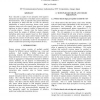Free Online Productivity Tools
i2Speak
i2Symbol
i2OCR
iTex2Img
iWeb2Print
iWeb2Shot
i2Type
iPdf2Split
iPdf2Merge
i2Bopomofo
i2Arabic
i2Style
i2Image
i2PDF
iLatex2Rtf
Sci2ools
ICMCS
2006
IEEE
2006
IEEE
Interactions and Integrations of Multiple Sensory Channels in Human Brain
Here I describe a couple of new principles with regard to interactions and integrations of multiple sensory channels in the human brain. First, as opposed to the general belief that the perception of shape and that of color are relatively independent of motion processing, human visual system integrates shape and color signals along perceived motion trajectory in order to improve visibility of shape and color of moving objects. Second, when the human sensory system binds the outputs of different sensory channels, (including audio-visual signals) based on their temporal synchrony, it uses only sparse salient features rather than using the time courses of full sensory signals. We believe these principles are potentially useful for development of effective audiovisual processing and presentation devices.
| Added | 11 Jun 2010 |
| Updated | 11 Jun 2010 |
| Type | Conference |
| Year | 2006 |
| Where | ICMCS |
| Authors | Shinya Nishida |
Comments (0)

